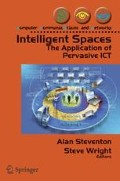Abstract
Mark Weiser had a vision of ubiquitous computing that was motivated by his belief that profound technologies disappear into the physical environment that surrounds us [1]. This vision has become a reality. Fewer than 2% of all microprocessors sold go into conventional PCs, the vast majority of the remainder becoming part of embedded systems, although few of these are currently networked. It is not, however, difficult to foresee that the efforts aimed at overcoming the inherent complexities in producing truly ubiquitous networked systems are most likely to bear fruit in the short to medium term.
Access this chapter
Tax calculation will be finalised at checkout
Purchases are for personal use only
Preview
Unable to display preview. Download preview PDF.
References
Weiser M. The Computer for the Twenty-first Century. Scientific American, 1991:256:94–104.
Grandison T. Trust Specification and Analysis for Internet Applications. PhD Transfer Report, Imperial College of Science, Technology and Medicine, Department of Computing, 2001.
Grandison T. Trust Management for Internet Applications. PhD thesis, Imperial College of Science, Technology and Medicine, Department of Computing, 2003.
McKnight D H and Chervany N L. The Meanings of Trust. University of Minnesota, 1996.
Abdul-Rahman A and Hailes S. Supporting Trust in Virtual Communities. 33rd Hawaii International Conference on System Sciences, 2000.
Chopra K and Wallace W. Trust in Electronic Environments. 36th Hawaii International Conference on System Sciences, 2003:331–340.
Marsh S. Formalising Trust as a Computational Concept. PhD thesis, Department of Computer Science and Mathematics, University of Stirling, 1994.
Seleznyov A and Hailes S. A Conceptual Access Control Model Based on Distributed Knowledge Management. IEEE, 18th International Conference on Advanced Information Networking and Applications, 2004.
Estrin D et al. Connecting the Physical World with Pervasive Networks. IEEE Pervasive Computing, 2002:1:1:59–69.
Kindberg T et al. People, Places, Things: Web Presence for the Real World. Proc WMCSA2000, 2001.
Eustice K et al. Enabling Secure Ubiquitous Interactions. 1st International Workshop on Middleware for Pervasive Ad Hoc Computing, 2003.
Stajano F. Security for Whom? The Shifting Security Assumptions of Pervasive Computing. Proceedings of International Security Symposium, Springer-Verlag, 2002.
Stajano F and Crowcroft J. The Butt of the Iceberg: Hidden Security Problems of Ubiquitous Systems. In: Basten T, Geilen M, and deGroot H (editors). Ambient Intelligence: Impact on Embedded System Design. Kluwer Academic Publishers, 2003.
Blaze M, Feigenbaum J, and Lacy J. Decentralized Trust Management. IEEE Symposium on Security and Privacy, 1996.
Kagal L et al. Centaurus: A Framework for Intelligent Services in a Mobile Environment. The 21st International Conference on Distributed Computing Systems Workshops (ICDCSW’ 01), 2001.
Kagal L et al. A Security Architecture Based on Trust Management for Pervasive Computing Systems. Grace Hopper Celebration of Women in Computing, 2002.
English C et al. Trusting Collaboration in Global Computing. The First International Conference on Trust Management, Springer-Verlag, 2003:2692:136–149.
Mui L, Mohtashemi M, and Halberstadt A. A Computational Model of Trust and Reputation. 35th Hawaii International Conference on System Sciences, 2004.
Veijalainen J, Seleznyov A, and Mazhelis O. Security and Privacy of the FTP. In: Makki K et al (editors). Mobile and Wireless Internet: Protocols, Algorithms, and Systems. Kluwer Academic Publishers, 2003:165–190.
Author information
Authors and Affiliations
Editor information
Editors and Affiliations
Rights and permissions
Copyright information
© 2006 Springer-Verlag London Limited
About this chapter
Cite this chapter
Seleznyov, A., Ahmed, M.O., Hailes, S. (2006). Co-operation in the Digital Age — Engendering Trust in Electronic Environments. In: Steventon, A., Wright, S. (eds) Intelligent Spaces. Computer Communications and Networks. Springer, London. https://doi.org/10.1007/978-1-84628-429-8_10
Download citation
DOI: https://doi.org/10.1007/978-1-84628-429-8_10
Publisher Name: Springer, London
Print ISBN: 978-1-84628-002-3
Online ISBN: 978-1-84628-429-8
eBook Packages: Computer ScienceComputer Science (R0)

